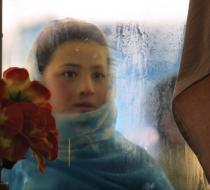Turning Art Into Activism Favorite
By David Gonzalez
Leslie Thomas wants to shock you. She wants to anger you. And above all, she wants you to do something.
She’s not talking about run-of-the-mill, “Hey buddy, watch your step” angry or TMZ sleaze shock. She’s talking about the great humanitarian and social crises of our time, like in Darfur, Afghanistan or Myanmar. And yes, she’s talking to you.
Ms. Thomas, an architect turned activist, is the founder of Art Works Projects, which uses photography to raise awareness of human rights concerns and spur action. Over the last five years it has mounted exhibitions and presented large-scale public slide projections on various themes. It has now published a book of images with accompanying posters and curriculums on the lives of women in Afghanistan. A wide-ranging retrospective opens in Slovenia on Tuesday.
“My goal is to be the most emotionally manipulative person possible,” she said, candidly. “Then I want to forge an emotional connection and get you to call or write and do something.”
When she was 12 years old, her father, an amateur photographer, took her to see a W. Eugene Smith show, which included his images from Minamata, Japan, where people had been victims of mercury poisoning.
“I grew up with the Ansel Adams postcards and the Sierra Club stuff all over our house,” she said. “Then my father took me to the Smith exhibit, where I saw ‘The Walk to Paradise Garden.’ My dad said: ‘Yeah, that’s a photo. But let me show you another one.’ He showed me Tomoko in her bath. I just crumbled to my knees. It was the ‘Pietà.’ After that, photojournalism always meant something to me.”
Though she thought she would be a journalist, she became an architect instead. She found herself drawn to making something rather than writing about something. Later, she went on to work as an art director on films, including “Introducing Dorothy Dandridge.”
Then she saw something that changed her course.
She had been reading about the genocide in Darfur and was struck by a photo of a boy whose face had been smashed because of his ethnicity.
“I was holding my own son at the time and was simply horrified that this was going on while the world stood by,” she recalled. “It was the middle of the night and I was so totally enraged that all I could do was write everyone I knew a letter asking them if they would join me in doing something. Anything.”
She wondered why a photo was needed at all, given the topic. But then she thought again. Maybe photos could move people to take action. Maybe she would do a documentary. Maybe she could project the images on the sides of buildings, turning open space into an open-air gallery.
“I didn’t know any photographers, I didn’t have any money and I didn’t know any film editors,” she said. “Other than that, it was a natural fit.”
She approached about 100 museums with the idea of the public projections. All turned her down, until the Hammer Museum in Los Angeles took her up in 2006. Over the next two years, the Darfur work was seen in dozens of venues, followed by a project on sexual violence against women in the Democratic Republic of Congo and another on child labor and human trafficking.
Working in the space between art and activism, Ms. Thomas says she has to carefully balance her approach and goals. She does not want to preach to the converted – the likely audience in a museum setting – but reach a wider audience who may not be up on the news. She provides information on the issues, so that people have a context and perhaps an idea what they can do to get involved.
Nor does she want viewers to feel overwhelmed, which is why she carefully selects images that outrage along with images that inspire.
“You have to hit it right,” she said. “You have to show them something they can identify with. You want them to be angry. You want them to do something. You can’t just shut them down. You have to give somebody something to fight for.”
Her Afghanistan project – “Women Between Peace and War” – is timed to keep in the spotlight the challenges facing women there as the foreign military presence prepares to wind down. Featuring the work of Stephanie Sinclair and Ron Haviv, among others, it is organized around themes including health, education and political participation. The range is varied, both in subject and emotion; subjects include a young female boxer and an 11-year-old bride.
The book, which includes posters that can be hung in classrooms, is intended for schools, and her group has already been discussing its use in a human rights curriculum in Chicago, where Ms. Thomas lives (and still works as an architect). She aims for an initial press run of 500 copies.
Financing these ventures is not easy. Foundations that fund the arts are sometimes uncomfortable with her issue-oriented work, while human rights groups sometimes think that the images are too nice. Others ask her how she measures her group’s impact.
“Humanitarian aid is easy to figure out,” she said. “Advocacy is harder. You’re trying to move people and policy, and that is like molasses. It takes a long time.”
You have to be patient. You have to be O.K. with failure. And you have to find comfort where you can. Even if it’s just in one person.
“You have to take solace in small moments, like changing an attitude, or somebody bothering to take the time to listen to someone’s story.”







